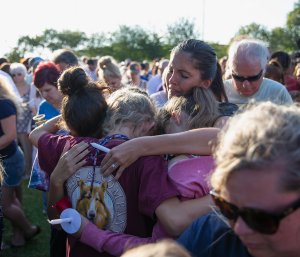At 7:45 Friday morning, Santa Fe High School sophomore Zachary Muehe was checking his cell phone while he waited for art class to start. Other students were chatting.

Then, he remembers with absolute clarity, he heard two loud blasts.
Muehe says he turned and saw one of his classmates, junior Dimitrios Pagourtzis, standing there, dressed as usual in his long, dark duster — apparently the same one that Pagourtzis had posted photos of with an Iron Cross and hammer-and-sickle insignia pinned to it.
He was holding a shotgun.
Muehe stared for a moment in shock.
One of his other classmates — he wasn’t sure which one — sprawled on the floor. Pagourtzis cradled the shotgun in one hand and lifted a .38 revolver with the other.
“He pointed the revolver at her and shot her,” Muehe said.
As the classroom erupted into pandemonium, Muehe jumped up and ran.
“All that was going through my head was to get out,” he recalled, recounting, just before a Friday night vigil held down the road from the high school, the moment when a shooting began that claimed the lives of eight students and two teachers, and that left 13 other people wounded.
On Friday morning, Santa Fe High became the site of the 22nd US school shooting in the first 20 weeks of this year. Pagourtzis, 17, was taken into custody and has cooperated with police, Galveston County Magistrate Mark Henry said.
Four weeks earlier, a handful of the 1,400 students at this high school, in a small town southeast of Houston, had taken part in the nationwide April 20 walkout to protest gun violence in schools. Now the violence had come to them.
In the second art classroom next door, freshman Aidan Porras said at the vigil on Friday night, he and the other students heard the three shots.
“Everybody freaked out and ran to the back of the classroom, but the door was locked,” he said. “Me and a couple of other people went to the ceramics room,” a small space between the Art 1 and Art 2 classrooms. They hid there, behind the heavy door inset with a glass window.
Muehe, too, had run toward the ceramics room, but then veered out into the hallway to the door of the classroom opposite.
“I banged on the door and shouted, ‘he has a gun!'” Muehe said. Then he ran out and across campus toward a nearby gas station, where he pulled out his phone and called 911.
The students hiding in the ceramics room heard other shots. Then a blast blew out the glass in the window of the door.
Pagourtzis, Muehe said, stuck the barrel of the shotgun through the window and fired.
Porras identified two particular students he shot. Then Pagourtzis forced open the door and shot a third student through the doorway, Porras said.
But then the police arrived, and Pagourtzis turned.
“He was arguing with the cops. They wanted him to put down his guns and surrender, but he said they’d shoot him. He was firing off rounds every so often.”
Porras didn’t see what happened between the police and Pagourtzis to end the shooting.
Through the day Friday, the school grounds remained closed as police searched for pipe bombs and other explosive devices Pagourtzis had allegedly scattered.
That evening, at the vigil, surrounded by other students and family and seemingly most of the town’s population, Porras, Muehe and other students remained baffled. As the late afternoon sun waned, a large crowd milled slowly in a grassy park next to a strip mall. Students chatted and hugged one another, many of them standing with their parents and siblings, holding candles. On a table at one end of the park, ten candles in glass jars were lit, one for each of the deceased, with flowers placed between them.
As local leaders gave comments and prayers through a set of underpowered speakers, the students only occasionally listened. It seemed to be just being together that mattered.
Pagourtzis had been quiet, according to classmates — he was a bit odd and kept to himself, wearing his long coat regardless of the weather. But nothing about him had seemed threatening, a number of students said. Muehe, whose locker was next to Pagourtzis’s, and who played on the junior varsity football team with him, said he wouldn’t have ever guessed he would do something so terrible.
One sophomore student, who asked not to be named, said he had been part of a small circle of Pagourtzis’s friends, for a time. “He was very interested in guns, and in World War II history, fascism, communism, military history.”
The day before the shooting, senior Tyler Ray said that Pagourtzis had been with him among a group of students who took a school trip to the Schlitterbahn water park in Galveston. He had seemed to enjoy himself just as they all had, he said.
Ray struggled to understand Pagourtzis. “He had to have been thinking about this for a while,” he said. But he gave no sign of anything amiss.
After they returned to the school from the water park, Ray said he’d chatted with Pagourtzis.
“He said hi to me and we talked for at least 15 minutes,” Ray said. “He seemed fine.”
Another classmate, Brooke Williams, reached by Facebook, agreed that there had been no inkling this week of the violence to come.
“He was friendly to me and funny,” Williams said. “I was just talking to him yesterday in our class and he didn’t show any signs of what was to happen today. … I’m horrified that it was my friend that did it. But it happened, and now it’s something he’s going to live with and so is all of the community.”




















